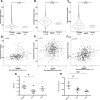Integrative analysis of loss-of-function variants in clinical and genomic data reveals novel genes associated with cardiovascular traits
- PMID: 31345219
- PMCID: PMC6657044
- DOI: 10.1186/s12920-019-0542-3
Integrative analysis of loss-of-function variants in clinical and genomic data reveals novel genes associated with cardiovascular traits
Erratum in
-
Correction to: Integrative analysis of loss-of-function variants in clinical and genomic data reveals novel genes associated with cardiovascular traits.BMC Med Genomics. 2019 Nov 5;12(1):154. doi: 10.1186/s12920-019-0573-9. BMC Med Genomics. 2019. PMID: 31684948 Free PMC article.
Abstract
Background: Genetic loss-of-function variants (LoFs) associated with disease traits are increasingly recognized as critical evidence for the selection of therapeutic targets. We integrated the analysis of genetic and clinical data from 10,511 individuals in the Mount Sinai BioMe Biobank to identify genes with loss-of-function variants (LoFs) significantly associated with cardiovascular disease (CVD) traits, and used RNA-sequence data of seven metabolic and vascular tissues isolated from 600 CVD patients in the Stockholm-Tartu Atherosclerosis Reverse Network Engineering Task (STARNET) study for validation. We also carried out in vitro functional studies of several candidate genes, and in vivo studies of one gene.
Results: We identified LoFs in 433 genes significantly associated with at least one of 10 major CVD traits. Next, we used RNA-sequence data from the STARNET study to validate 115 of the 433 LoF harboring-genes in that their expression levels were concordantly associated with corresponding CVD traits. Together with the documented hepatic lipid-lowering gene, APOC3, the expression levels of six additional liver LoF-genes were positively associated with levels of plasma lipids in STARNET. Candidate LoF-genes were subjected to gene silencing in HepG2 cells with marked overall effects on cellular LDLR, levels of triglycerides and on secreted APOB100 and PCSK9. In addition, we identified novel LoFs in DGAT2 associated with lower plasma cholesterol and glucose levels in BioMe that were also confirmed in STARNET, and showed a selective DGAT2-inhibitor in C57BL/6 mice not only significantly lowered fasting glucose levels but also affected body weight.
Conclusion: In sum, by integrating genetic and electronic medical record data, and leveraging one of the world's largest human RNA-sequence datasets (STARNET), we identified known and novel CVD-trait related genes that may serve as targets for CVD therapeutics and as such merit further investigation.
Keywords: Cardiovascular traits; Electronic Medical Records; Genetic association; Integrative data analysis; Loss-of-function variant; Target identification and validation.
Conflict of interest statement
KLA, EES, SDL, and RC are employees of Sema4, a Mount Sinai venture. OF, AR, EES, and JLMB are employees of Clinical Gene Networks AB. The rest of authors declare they have no competing interest.
Figures




References
Publication types
MeSH terms
Substances
Grants and funding
LinkOut - more resources
Full Text Sources
Miscellaneous

